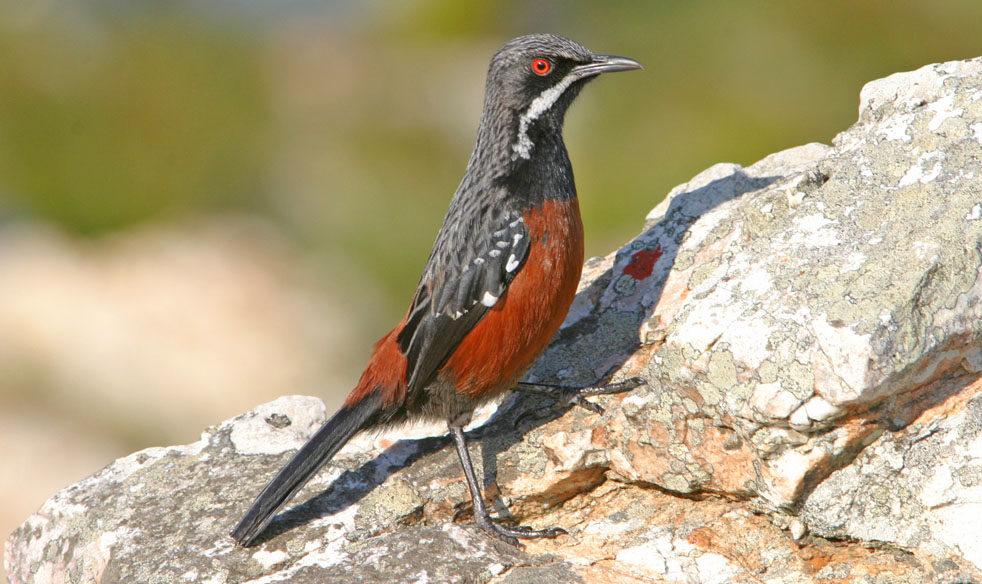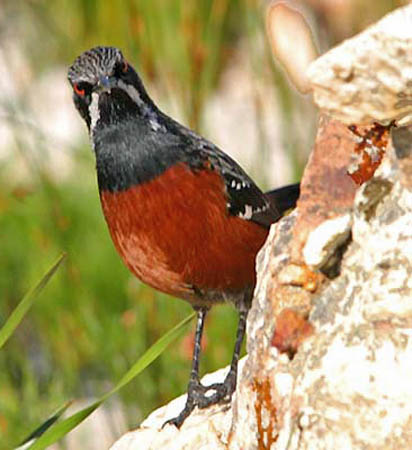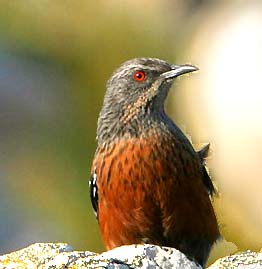
a web page by Don Roberson |
ROCKJUMPERS Chaetopidae |
|
This turns out to be as preposterously wrong as about any taxonomic assignment ever made. The Rockjumpers are, in fact, among the most interesting passerine birds on earth. First, they live in rocky habitat with few shrubs, and run through their territories like small weasels. They are sexually dimorphic with colorful males and more subdued females. They have cooperative breeding strategies. They are curious and engaging birds. I love this shot (left) of a male Cape Rockjumper peering out at me from behind a boulder, having run through the jumbled rocks to see who had entered his territory. Second, it turns out that these birds are one of the earliest living passerines to evolve on earth. That story in a moment. For now, please take in the beauty of this wonderful thrasher-sized bird full profile of a male Cape Rockjumper (below) about 5 feet away: |
 |
|
All prior theories about the relationships of these birds were tossed aside when Sibley & Ahlquist (1990) presented initial molecular evidence that the rockjumpers were more closely related to the two species of rockfowl (Picathartes) of central and west Africa than to any other birds on earth. Although it seems apparent that rockjumpers and rockfowl are really not similar — Picathartes live in thick tropical rainforest, forage on the ground like ground-cuckoos, and built mud nests inside caves — the evidence showed they were more closely related to each other than to other birds. So, naturally, Sibley & Monroe (1990) put the two groups together in family Picathartidae, and then settled them between their huge corvoid assemblage and the Passerida. I did a little work for Charles Sibley during his last years in the mid-1990s and I argued with him about his assignments of these two unique sets of birds. Even if they were each others nearest relatives, that doesn't mean they must be in the same family! There just is no logic, rhyme, or reason to throw the rockjumpers -- sexually dimorphic arid country birds — into the unique family [Picathartidae] of jungle-dwelling, cave-nesting rockfowl. New and more direct genetic research confirms that rockjumpers and rockfowl are each others nearest relations (e.g., Barker et al. 2004, Cracraft et al. 2004, Beresford et al. 2005). These new data show that the rockfowl and rockjumpers evolved at the base of the passerine tree of life, diverging from the rest of the 'songbirds' about 44.5 million years ago. The Gondwana continents were just them breaking apart — Africa had early separated from South America about 90 millions years ago (e.g., Erickson et al. 2001) — but other continents were not yet in modern form. The molecular evidence suggests that rockjumpers separated from rockfowl, and each group began its own unique evolutionary past, about 31.2 million years ago (Beresford et al. 2005). Some of the recent papers maintain rockjumpers in the Picathartidae reluctantly, as if they were bound by tradition to do so (at best, the 'tradition' is less than two decades old). The give a sidewise hint that perhaps rockjumpers should be in their own family. The two dissimilar taxa took separate evolutionary paths over 31 million years ago. Other groups — which "everyone" maintains as families (e.g., starlings from thrashers, dippers from thrushes, etc) — diverged much more recently in evolutionary time. It is apparent to me — if to no one else — that rockjumpers must logically be in their own family [Chaetopidae]. So that is what I do here. One other point that sometimes mucks up the discussion: Dickinson (2003) follows Olson (1998) in lumping the Namibian endemic Rockrunner Achaetops pycnopygius into the genus Chaetops. Some recent books and checklists even use the ridiculous name "Damara Rockjumper" for Rockrunner. Dickinson (2003) goes even further out in left field, and lumps the two South African rockjumpers together as one species. Newer molecular evidence (Beresford et al. 2005) confirms that the Rockrunner of Namibia is among a group of African sylvoids, including Cape Grassbird Sphenoeacus afer, Victorin's Warbler 'Bradypterus' victornini, and the crombecs (Sylvietta sp.). In other words, the Rockrunner is among the Old World warbler/babbler set of birds, an assemblage that may be split into multiple families when all is said and done (e.g., Barker et al. 2004, Beresford et al. 2005). In short, Achaetops [Rockrunner] is not remotely related to Chaetops [Rockjumpers]. [Note: The above rant was my take on things back in 2005. The taxonomic world shared by ornithologists and field birders has since calmed down, and basically everything advocated above is now long-settled conventional opinion. And I've cut back on the coffee . . .] |
Photos: Both the male and female Cape Rockjumper Chaetops frenatus, and the habitat, were photographed near the shores of Walker Bay, just east of Cape Town, South Africa, on 2 July 2005. The late William (Bill) Rydell photographed the Orange-breasted Rockjumper Chaetops aurantius in Lesotho in Sep 1996. All photos © Don Roberson, except the Ornage-breasted Rockjumper credited © Bill Rydell, and used with permission; all rights reserved. Bibliographic note: There is no "family book" and the Handbook of the Birds of the World missed their opportunity to do a chapter on the Chaetopidae, throwing the rockjumpers into the trash heap of an expansive Babbler section (pp. 290–291 in Collar & Robson 2007). Literature cited:
|
 Rockjumpers are an enigmatic set of two species in the genus Chaetops. They are found only in South Africa and Lesotho. One species (Cape Rockjumpers) lives on rocky hills near the coast; the other (Orange-breasted Rockjumper) lives in higher montane scree farther east. They are so obscure that they weren't' even mentioned in the texts I looked at while I was growing up (e.g., Austin & Singer 1961) and, until very recently, if anyone thought of them at all, they were considered to be odd thrushes (e.g., South African field guide, Sinclair et al. 1993).
Rockjumpers are an enigmatic set of two species in the genus Chaetops. They are found only in South Africa and Lesotho. One species (Cape Rockjumpers) lives on rocky hills near the coast; the other (Orange-breasted Rockjumper) lives in higher montane scree farther east. They are so obscure that they weren't' even mentioned in the texts I looked at while I was growing up (e.g., Austin & Singer 1961) and, until very recently, if anyone thought of them at all, they were considered to be odd thrushes (e.g., South African field guide, Sinclair et al. 1993).  Look at how short the wings are in the photo above. This bird clearly does not fly very much, and is entirely resident and sedentary. Here (right) is a shot of typical Rockjumper habitat. Although it doesn't look like there is much cover, the birds are amazingly quick to 'disappear' among the rocks. The female Cape Rockjumper (below) is more subdued in plumage, and reminds me of any overgrown grasswren (Amytornis), which are themselves elusive ground-dwelling passerines in Australia. Recent research (Holmes et al. 2002) found that pairs occupy exclusive territories, but that often 1-2 other birds, usually the offspring from the previous breeding season, help in territorial defense, nest building, incubation, and feeding young. This makes Cape Rockjumper a socially monogamous, cooperative-breeding species.
Look at how short the wings are in the photo above. This bird clearly does not fly very much, and is entirely resident and sedentary. Here (right) is a shot of typical Rockjumper habitat. Although it doesn't look like there is much cover, the birds are amazingly quick to 'disappear' among the rocks. The female Cape Rockjumper (below) is more subdued in plumage, and reminds me of any overgrown grasswren (Amytornis), which are themselves elusive ground-dwelling passerines in Australia. Recent research (Holmes et al. 2002) found that pairs occupy exclusive territories, but that often 1-2 other birds, usually the offspring from the previous breeding season, help in territorial defense, nest building, incubation, and feeding young. This makes Cape Rockjumper a socially monogamous, cooperative-breeding species.
 Orange-breasted Rockjumper (male, right, in a photo by Bill Rydell) lives in talus slopes above 2000m in the mountains of eastern South Africa and Lesotho. Other than living at higher elevations, it differs primarily in being somewhat paler and by the male's pale orange, not burgundy, breast. Both species give a piping whistle and a bubbling song, but I can find rather little else about their ecology. It appears that, in general, these are not well studied birds.
Orange-breasted Rockjumper (male, right, in a photo by Bill Rydell) lives in talus slopes above 2000m in the mountains of eastern South Africa and Lesotho. Other than living at higher elevations, it differs primarily in being somewhat paler and by the male's pale orange, not burgundy, breast. Both species give a piping whistle and a bubbling song, but I can find rather little else about their ecology. It appears that, in general, these are not well studied birds.